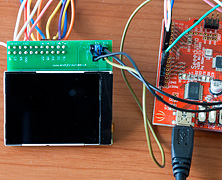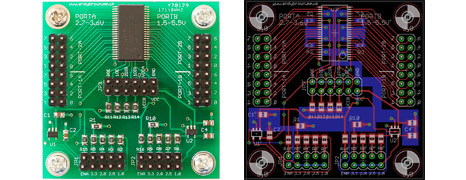In this, the latest instalment of my Nokia QVGA TFT reverse engineering series, I will take on the 2.8 inch 24-bit TFT that is designed to work with the Nokia N95 8Gb mobile phone. Read on to see how it worked out. Background In the first of my reverse engineering articles I tackled the Nokia 2730 display. I successfully discovered enough of the command set to write a driver for the Arduino and the STM32. Flush with that success I moved on to tackle the Nokia 6300 and the Nokia N82. I was lucky in that these two shared the same pinout and command set as the 2730 so I could produce a development board with little difficulty. The N95...
An Ethernet PHY for the STM32F107 and STM32F4
posted by Andy
A what? If you’ve never crossed paths with ethernet technologies before then you may not know what an ethernet PHY is. Well, it’s the physical transceiver that converts a well-known data-bus protocol implemented by your MCU into the physical signals that go down the wire. MCU...
Nokia N82 2.4 inch QVGA TFT on the Arduino
posted by Andy
It’s been a few months now since I released the original two articles that detailed the design, build and optimised software library for the 2.0″ Nokia 6300 QVGA TFT connected to the Arduino Mega XMEM interface. Judging by the responses I’ve had, there’s a lot of you...
Interfacing the Nokia 6300 QVGA TFT to the standard Arduino
posted by Andy
In two of my previous articles (here and here) I explained how we could connect the 8-bit 8080 interface presented by the TFT panel to the XMEM interface of the Arduino Mega to achieve a high performance full-colour graphical interface. I went on to present a high-performance open-source...
stm32plus: ILI9327 TFT driver
posted by Andy
The code presented in this article requires a minimum of version 3.0.0 of my stm32plus library. The TFT panel The ILI9327 is a driver IC for 432×240 (WQVGA) panels. The panels are typically found in mobile phones; LG went through a phase of producing lots of phones with...
Nokia QVGA TFT LCD for the Arduino Mega. Design and build (part 1 of 2)
posted by Andy
In two of my previous articles I showed you how to reverse engineer the Nokia 2730 LCD for connecting to a device with 3.3V I/O’s and then I showed you how to build a 16-channel level converter for connecting devices together that have differing I/O level requirements. This article...
Nokia QVGA TFT LCD for the Arduino Mega. Graphics Library (part 2 of 2)
posted by Andy
In part 1 of this two part series I presented the hardware design and build for the Nokia 6300 TFT that shows how we can connect it directly to the external memory interface of the Arduino Mega and that by doing so we achieve the fastest possible interface between the TFT and the Arduino...
16 channel level converter with dual regulators
posted by Andy
If, like me, you’ve spent a lot of tinkering with things like TFT modules and other highly integrated peripherals then you’ll be familiar with the depressing section in the device datasheet that looks like this: The DC characteristics table tells you the voltages that a device expects to receive and these days it’s common for multiple voltage levels to be expected and sadly for those of us that still occasionally use the Arduino, 5V (TTL) level tolerance is becoming rarer as manufacturers switch over to ever lower CMOS voltages. Even though I mostly use the STM32 3.3V ARM MCU it’s still quite common to see a...








